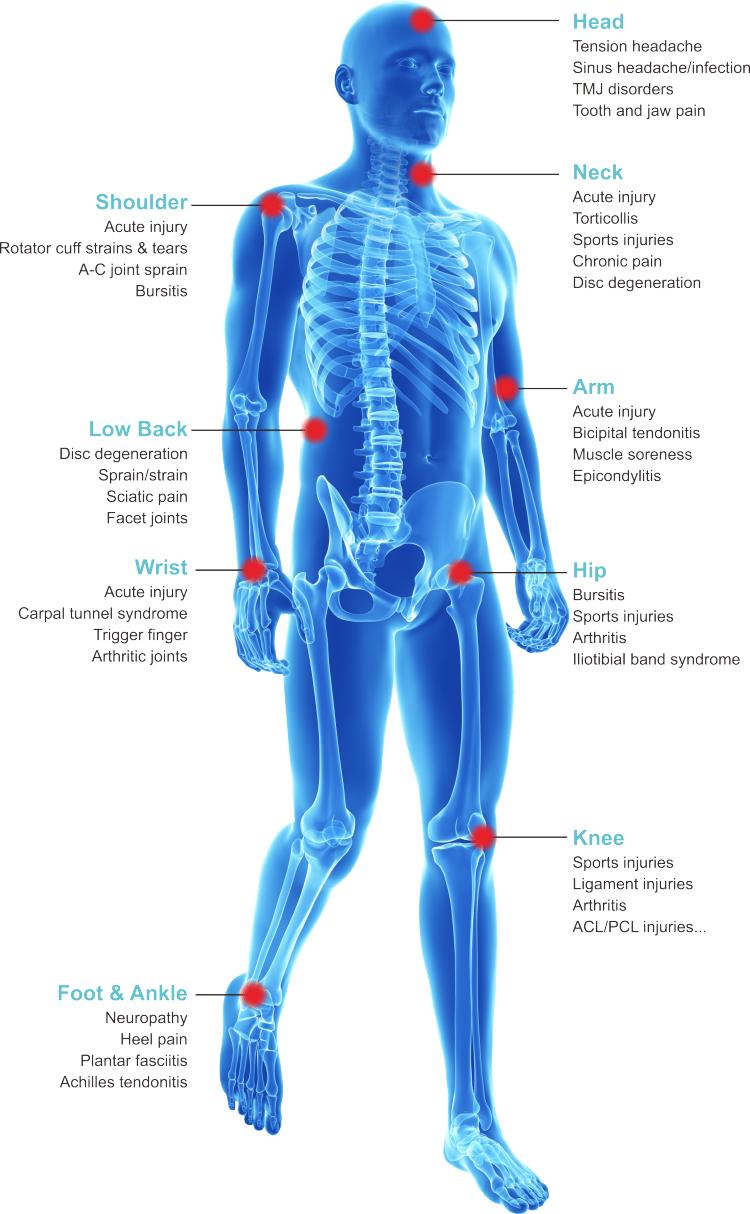The high power laser therapy especially in combination with the other therapies we provide such as active release techniques soft tissue treatment. Yaser high intensity Class IV laser physiotherapy equipment can also be used to treat:
 *Arthritis
*Arthritis
*Bone spurs
*Plantar Fascitis
*Tennis Elbow (Lateral Epicondylitis)
*Golfers Elbow (Medial Epicondylitis)
*Rotator Cuff Strains and Tears
*DeQuervains Tenosynovitis
*TMJ
*Herniated Discs
*Tendinosis; Tendinitis
*Enthesopathies
*Stress Fractures
*Shin Splints
*Runners Knee (Patellofemoral Pain Syndrome)
*Carpal Tunnel Syndrome
*Ligament Tears
*Sciatica
*Bunions
*Hip Discomfort
*Neck Ache
*Back Pain
*Muscle Strains
*Joint Sprains
*Achilles Tendinitis
*Nerve Conditions
*Healing After Surger
Biological Effects Of Laser Therapy By Laser Physiotherapy Equipment
1. Accelerated Tissue Repair And Cell Growth
Accelerate cellular reproduction and growth. No other physical therapy modality can penetrate the bony patella and deliver healing energy to the articular surface between the underside of the patella and the femur. Cells of cartilage, bone, tendons, ligaments and muscles are repaired faster as a result of exposure to laser light.
2. Reduced Fibrous Tissue Formation
Laser therapy reduces the formation of scar tissue following tissue damage and acute and chronic inflammatory processes. This point is paramount because fibrous (scar) tissue is less elastic, has poorer circulation, is more pain sensitive, weaker, and much more prone to re-injury and frequent exacerbation.
3. Anti-Inflammation
Laser light therapy has an anti-inflammatory effect, as it causes vasodilation and activation of the lymphatic drainage system. As a result, there is a reduction in swelling caused by biomechanical stress, trauma, overuse, or systemic conditions.
4. Analgesia
Laser therapy has a beneficial effect on pain through the suppression of nerve signal transmission over unmyelinated c-fibers that transmit pain to the brain. This means that a greater amount of stimuli is required to create an action potential within the nerve to signal pain. Another pain blocking mechanism involves the production of high levels of pain killing chemicals such as endorphins and enkephalins from the brain and adrenal gland.
5. Improved Vascular Activity
Laser light will significantly increase the formation of new capillaries (angiogenesis) in damaged tissue that will speed up the healing process. Additionally, it has been noted in the literature that microcirculation increases secondary to vasodilation during laser treatment.
6. Increased Metabolic Activity
Laser therapy creates higher outputs of specific enzymes
7. Improved Nerve Function
Class IV laser therapeutic machine accelerates the process of nerve cell regeneration and increases the amplitude of action potentials
8. Immunoregulation
Stimulation of immunoglobulins and lymphocytes
9. Stimulates Trigger Points and Acupuncture Points
Stimulates muscle trigger points, restoration of muscular tonus and balance
Cold Vs Hot Therapeutic Laser
The majority of therapeutic laser equipments used are commonly known as "cold lasers". These lasers have very low power and for that reason do not generate any heat on the skin. Treatment with these lasers is known as "Low Level Laser Therapy" (LLLT).
The lasers we use are "hot lasers". These lasers are much more powerful than cold lasers normally more than 100x more powerful. Therapy with these lasers feels warm and soothing because of the higher energy. This therapy is known as "High Intensity Laser Therapy" (HILT).
Both hot and cold lasers have similar depth of penetration into the body. The depth of penetration is determined by the wavelength of light and not the power. The difference between the two is the time it takes to deliver a therapeutic dose. A 15 watt hot laser will treat an arthritic knee to the point of pain relief, in about 10 minutes. A 150 milliwatt cold laser would take over 16 hours to deliver the same dose.
Post time: Jul-06-2022
